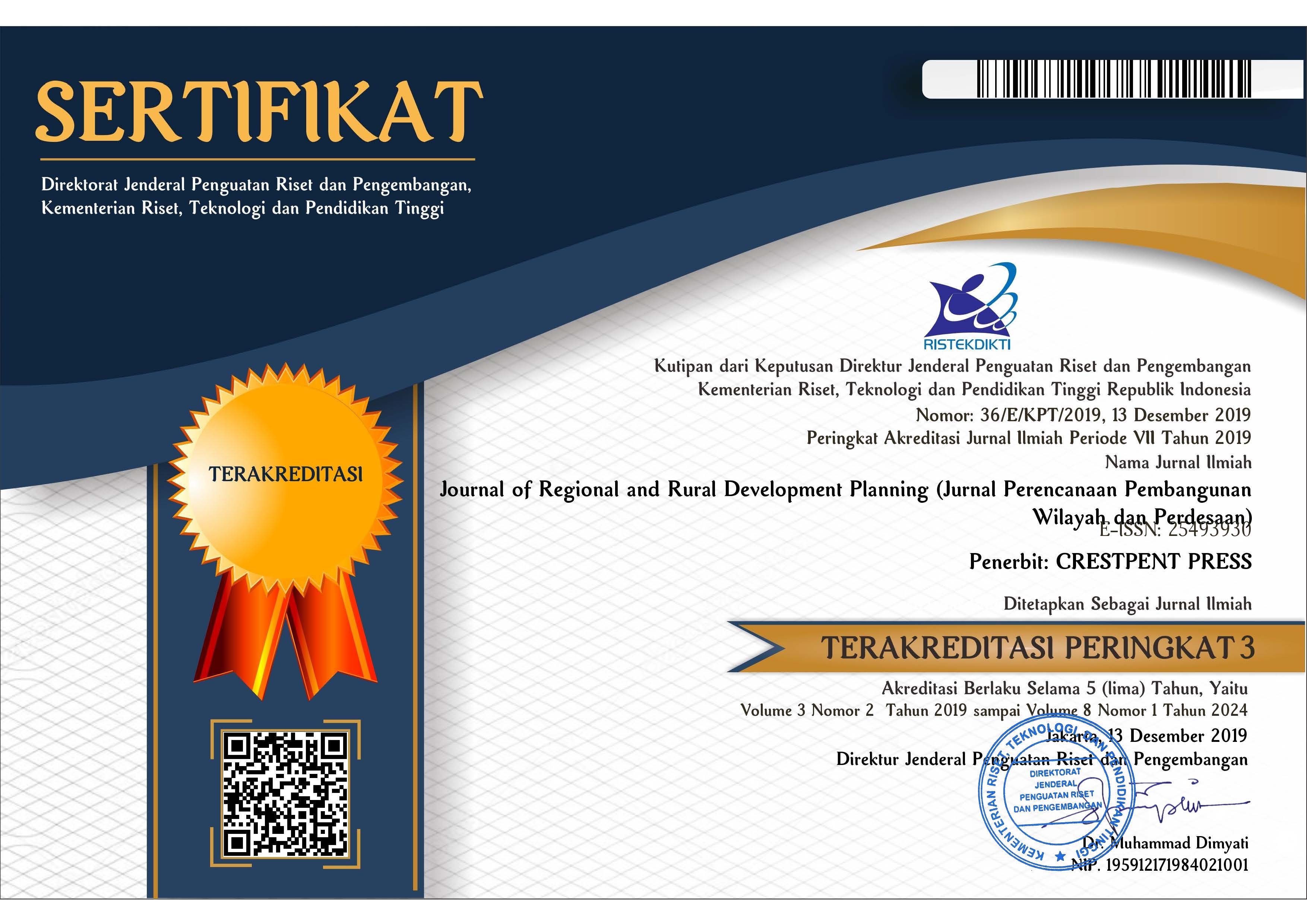Keragaman Agama, Etnis, Bahasa, dan Pembangunan Desa
Diversity of Religions, Ethnicities, Languages, and Village Development
Abstract
The diversity of religions, ethnicities and languages that exist in Indonesia could either be a barrier or a driver for rural development and has been receiving more attention in recent years. The purpose of this study is to analyze the long-term influence of the existence of residents with different religions, ethnicities, and daily languages in a village-on-village development. This research uses descriptive analysis and inferencing with multiple linear regression. Results of the multiple linear regression analysis show that the existence of residents of different religions and ethnicities has a positive impact on village development, but the various languages used daily have the opposite effect. In addition, the existence of credit facilities received by residents, the presence of health workers in the village, and the village topography have high enough influence on village development.
References
Ahmad, N. & Amin, S. (2020). Does ethnic polarization stimulate or relegate trade and environmental performance? A global perspective. Environment, Development and Sustainability, 22 (7), 6513–6536. https://doi.org/10.1007/s10668-019-00497-z
Anggriyani, D. S. & Dartanto, T. (2019). Unity in diversity: Socioeconomic aspects and growth of conflict in indonesia. International Journal of Business and Society, 20 (S1), 197–209.
Bappenas. (2017). Ringkasan Metadata Tujuan Pembangunan Berkelanjutan (TPB)/ Indikator Sustainable Development Goals (SDGs) Indonesia. In Kementerian PPN / Bappenas.
Barrios, E. B. (2008). Infrastructure and rural development: Household perceptions on rural development. Progress in Planning, 70 (1), 1–44. https://doi.org/10.1016/j.progress.2008.04.001
BPS. (2011a). Kewarganegaraan, Suku Bangsa, Agama, dan Bahasa Sehari-hari Penduduk Indonesia.
BPS. (2011b). Statistik Potensi Desa Indonesia 2011.
BPS. (2014). Statistik Potensi Desa Indonesia [Village Potential Statistics of Indonesia] 2014.
BPS. (2018a). Indeks Pembangunan Desa 2018.
BPS. (2018b). Indonesia Population Projection 2015-2045 Result of SUPAS 2015 (Revised Edition).
BPS. (2018c). Village Potential Statistics of Indonesia 2018.
Cowie, P., Townsend, L., & Salemink, K. (2020). Smart rural futures: Will rural areas be left behind in the 4th industrial revolution? Journal of Rural Studies, 79 (August), 169–176. https://doi.org/10.1016/j.jrurstud.2020.08.042
Churchill, S. A., Madhoo, Y. N., & Nath, S. (2020). Ethnic diversity and human capital development in India: A disaggregated analysis at the state and district levels. Applied Economics, 52 (5), 506–518. https://doi.org/10.1080/00036846.2019.1646880
Churchill, S. A. & Smyth, R. (2017). Ethnic Diversity and Poverty. World Development, 95 (3), 285–302. https://doi.org/10.1016/j.worlddev.2017.02.032
Faoziyah, U. & Salim, W. (2020). Seeking prosperity through village proliferation: An evidence of the implementation of village funds (Dana Desa) in Indonesia. Journal of Regional and City Planning, 31 (2), 97–121. https://doi.org/10.5614/jpwk.2020.31.2.1
Grabowski, M. & Laidler, P. (2018). The Economic and Political Dimensions of Development in the 21st Century.
Harsono, M. (2002). Prosedur Pengujian Variabel Kontrol Dan Moderator Dalam Penelitian Perilaku Dengan Menggunakan Spss 10.00*). Jurnal Jurusan Manajemen Fakultas Ekonomi Universitas Sebelas Maret Variabel, 1–7.
Huntington, S. P. (1993). The clash of civilizations? Foreign Affairs, 72 (3), 22–49. https://doi.org/10.4324/9781003060963-50
Marsden, T. (2010). Mobilizing the regional eco-economy: Evolving webs of agri-food and rural development in the UK. Cambridge Journal of Regions, Economy and Society, 3 (2), 225–244. https://doi.org/10.1093/cjres/rsq010
Nurlinah, Haryanto, & Sunardi. (2020). New development, old migration, and governance at two villages in Jeneponto, Indonesia. World Development Perspectives, 19 (June), 100223. https://doi.org/10.1016/j.wdp.2020.100223
Qin, X., Li, Y., Lu, Z., & Pan, W. (2020). What makes better village economic development in traditional agricultural areas of China? Evidence from 338 villages. Habitat International, 106 (July), 102286. https://doi.org/10.1016/j.habitatint.2020.102286
Rennie, F. (2003). Rural health workers as a resource for rural development. Rural Society, 13 (2), 126–137. https://doi.org/10.5172/rsj.351.13.2.126
Riyanto & Wikarya, U. (2018). Statistika Ekonomi dan Bisnis (1st ed.). Jakarta: Mitra Wacana Media.
Salim, A., Bulan, W. R., Untung, B., Laksono, I., & Brock, K. (2017). Indonesia ’ s Village Law : enabler or constraint for more accountable governance ?
Xiaojian, L. & Xinsheng, F. (2010). Geography and rural household income: A village level study in Henan Province, China. Chinese Geographical Science, 20 (1), 001–008. https://doi.org/10.1007/s11769-010-0001-8
Ying, Z., Liu, S., Bao, S., & Zhou, J. (2017). Religious diversity and regional development in China. China Economic Review, 46 (August), 1–9. https://doi.org/10.1016/j.chieco.2017.08.003
Copyright (c) 2021 Journal of Regional and Rural Development Planning (Jurnal Perencanaan Pembangunan Wilayah dan Perdesaan)

This work is licensed under a Creative Commons Attribution-ShareAlike 4.0 International License.




.png)














